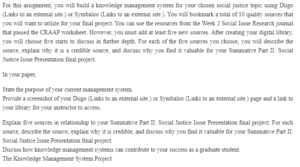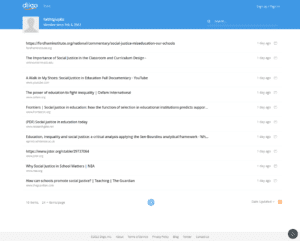Social Justice in Education
Social justice in education is a topic that attracts intense debate and controversy (Rochester, 2017). Individuals from varying schools of thought feel differently about the issue and its application in learning institutions (Merrimack College, 2022). To access the most valuable information for this study, it is necessary to examine different resources thoroughly. Various knowledge management tools can be used to conduct this process. Diigo will be used to organize and highlight critical information related to the topic. A valid resource provides current information that can be verified and is expert-based, highlighting potential loopholes in the current educational system.
Purpose of Diigo
Diigo is a knowledge management system that enables learners to store essential resources and highlight key aspects of their studies or research. The system is easy to use and allows one to add as many resources as possible. While using Diigo, a student can quickly locate crucial resources now and in the future. Reading these resources is also easy because the annotation tool enables highlighting critical ideas. It is also possible to share these links with others. The organization of information on Diigo is also accessible using tags and lists. Collaboration of data and information is an effortless process while using Diigo. The workflow and research processes are revolutionized by Diigo (Diigo, Inc., 2022).
Link
https://www.diigo.com/user/faithtgiuy8u?filter=bookmark
Screenshot
Sources
Alvarez, B. (2019). Why Social Justice in School Matters. Retrieved from National Education Association: https://www.nea.org/advocating-for-change/new-from-nea/why-social-justice-school-matters
This resource is credible for assorted reasons. First, the help is published on a website associated with educational matters, the National Educational Association (NEA), an organization as indicated in its URL. NEA is a recognized organization that seeks to advance the public education cause. It has more than three million educators who are members. These members represent at least 14,000 communities (Alvarez, 2019). Secondly, the resource is not older than five years, which means the published information is relevant to current times. Thirdly, the help is a collection of professional views and experiences from educators in different states of the USA. This means the varied information from other regions ensures objective and impartial information. It also proves that social justice’s highlighted issues in education are not unique to any specific state. Fourthly, the source uses professional language particular to the educational sector. These aspects are valuable to the research because they will provide the confidence to present the information articulated by the featured experts. It also includes information other researchers may have missed or overlooked, adding more meaning to the study.
Tickle, L. (2015). How can schools promote social justice? The Guardian. Retrieved from https://www.theguardian.com/education/2015/nov/03/schools-promote-social-justice
This resource is published in the Guardian, a weekly periodical. The help entails professional opinions on promoting social justice in schools. The main contributors are educators, directors, and commissioners to agencies in the sector and founders of education-related organizations. Experts’ professional opinion increases the source’s validity and value. It highlights issues that are not sufficiently addressed from an expert’s perspective. The resource gives insight into issues that other scholars or researchers may overlook. Mostly, such problems are ignored because they are not in the limelight (Walker, Pearce, Boe, & Lawson, 2019). Consequently, this promotes ignorance, which can be eliminated by discussing the issues.
Autin, F., Batruch, A., & Butera, F. (2015). Social justice in education: how the function of selection in educational institutions predicts support for (non)egalitarian assessment practices. Front. Psychol., 6. doi:https://doi.org/10.3389/fpsyg.2015.00707
This journal is a good source of information because it addresses the issue of social justice induction with greater specificity. The scholars investigate two main elements: normative and formative assessments. They conduct research using various techniques to arrive at a specific conclusion. The study also provides a reference list, allowing readers to verify the information discussed. Using primary data collection methods such as questionnaires highlights the likelihood of establishing current information and expanding the knowledge body. In addition, this additional information is beneficial not only to students but also to educators who may seek to improve social justice education in the schools.
K-State College of Education. (2016). A walk in my shoes: social justice in education. YouTube. Retrieved from https://www.youtube.com/watch?v=QWdcN2RSHhI
This resource is a compilation of vocal information that educators provide. YouTube videos are a valid resource because they allow for professional opinions from different experts in the education sector. Listening to the video highlights aspects that directly affect educators and learners. These issues may not be open because researchers conduct varied investigations. Despite having immense information on the same topic, essential and recent information may be lacking because education and social justice issues evolve constantly. As the case suggests, the video provides different personal accounts regarding the social justice aspects of education. This contributes primary data to the current research and adds value because new information is highlighted.
Hart, C. S. (2019). Education, Inequality and social justice: a critical analysis applying the Sen-Bourdieu analytical framework. Policy Futures in Education, 17(5), 582-598.
This resource is a journal that is less than five years old. The help is valid because it highlights various inequalities that affect the pursuit of social justice in education. The author argues that the current assessments of various educational resources are primarily deficient because they do not provide sufficient information. They fail to highlight most of the injustices that learners encounter. The study offers relatively new information that stakeholders do not willingly highlight. It pinpoints the loopholes in current educational assessments (Nieuwenhuis, 2010). This information is critical because it is valuable to educators who pursue social justice in education as well as administrators. Using the journal as a resource is ideal because it provides references that readers can use to verify the information. Using different information from various authors eliminates any possible partiality and promotes objectivity.
Conclusion
A valid resource provides the latest information that can be verified and is expert-based, highlighting potential loopholes in the current educational system. In most instances, information made accessible to the public is similar. This situation creates a need to seek out current info. For this reason, the use of resources that include personal accounts of educators and other experts on the issue is prominent. These resources provide data based on actual experiences and professional opinions of the various experts. Such information adds value to the research because it builds on the body of knowledge and highlights overlooked or unknown loopholes.
References
Alvarez, B. (2019). Why Social Justice in School Matters. Retrieved from National Education Association: https://www.nea.org/advocating-for-change/new-from-nea/why-social-justice-school-matters
Autin, F., Batruch, A., & Butera, F. (2015). Social justice in education: how the function of selection in educational institutions predicts support for (non)egalitarian assessment practices. Front. Psychol., 6. doi:https://doi.org/10.3389/fpsyg.2015.00707
Diigo, Inc. (2022). About Diigo. Retrieved from Diigo: https://www.diigo.com/about
Hart, C. S. (2019). Education, Inequality and social justice: a critical analysis applying the Sen-Bourdieu analytical framework. Policy Futures in Education, 17(5), 582-598.
K-State College of Education. (2016). A walk in my shoes: social justice in education. YouTube. Retrieved from https://www.youtube.com/watch?v=QWdcN2RSHhI
Merrimack College. (2022). The Importance of Social Justice in the Classroom and Curriculum Design. Retrieved from Merrimack College: https://online.merrimack.edu/social-justice-in-the-classroom/
Nieuwenhuis, J. (2010). Social justice in education today. Acta Academica , 43(1), 189-210.
Rochester, J. M. (2017). Social justice miseducation in our schools. Retrieved from https://fordhaminstitute.org/national/commentary/social-justice-miseducation-our-schools
Tickle, L. (2015). How can schools promote social justice? The Guardian. Retrieved from https://www.theguardian.com/education/2015/nov/03/schools-promote-social-justice
Walker, J., Pearce, C., Boe, K., & Lawson, M. (2019). The Power Of Education to Fight Inequality. Oxfam GB.
ORDER A PLAGIARISM-FREE PAPER HERE
We’ll write everything from scratch
Question
For this assignment, you will build a knowledge management system for your chosen social justice topic using Diigo (Links to an external site.) or Symbaloo (Links to an external site.). You will bookmark a total of 10 quality sources that you will want to utilize for your final project. You can use the resources from the Week 2 Social Issue Research journal that passed the CRAAP worksheet. However, you must add at least five new sources. After creating your digital library, you will choose five starts to discuss further. For each of the five sources you choose, you will describe the source, explain why it is a credible source, and discuss why you find it valuable for your Summative Part II: Social Justice Issue Presentation final project.

Social Justice in Education
In your paper,
State the purpose of your current management system.
Provide a screenshot of your Diigo (Links to an external site.) or Symbaloo (Links to an external site.) page and a link to your library for your instructor to access.
Explain five sources in relationship to your Summative Part II: Social Justice Issue Presentation final project. For each source, describe the source, explain why it is credible, and discuss why you find it valuable for your Summative Part II: Social Justice Issue Presentation final project.
Discuss how knowledge management systems can contribute to your success as a graduate student.
The Knowledge Management System Project



